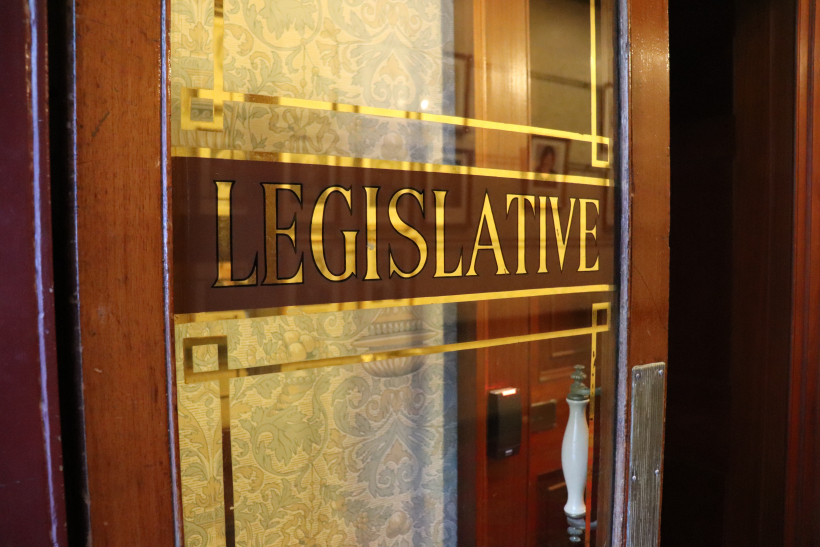Learning Outcomes
- Outline the concept of the ‘separation of powers’
- Describe the role of each branch of government in Australia and NSW
- Explain the difference between parliament and government
- Explain the difference between ‘separation of powers’ and ‘division of powers’
Syllabus Links
Legal Studies Preliminary Course
Part I: The legal system
2. Sources of contemporary Australian law:
- the constitution
- separation of powers
What is Separation of Powers?
In a democracy the doctrine of the separation of powers exists to ensure that the people chosen to make laws are not the same people who are charged with executing them. In addition, a separate body exists to review the law makers and the people that execute the laws they make. This is one of the foundations for the creation of fair government. The result is that the institutions of government are divided into three branches:
- Legislative
- Executive
- Judicial
The legislature makes the laws, the executive put the laws into operation, and the judiciary interprets the laws. No one branch can control all power in a democratic system.
In Australia the separation of powers is combined with another doctrine called responsible government by which members of the government (Ministers) are also members of parliament and are accountable (responsible) to the parliament .
This is an essential aspect of the Westminster system that Australia inherited from Britain. It means that in Australia the separation of powers is not as defined as in nations that have a Presidential system of government such as France and the USA.


Pocket Commonwealth Constitution
“Chapters I, II, and III of the Constitution confer the legislative, executive, and judicial powers of the Commonwealth on three different bodies which are established by the Constitution – the Parliament (Chapter I), the Executive Government (Chapter II), and the Judicature (Chapter III).
Legislative power is the power to make laws. Executive power is the power to administer laws and carry out the business of government, through such bodies as government departments, statutory authorities and the defence forces. Judicial power is the power to conclusively determine legal disputes, traditionally exercised by courts in criminal trials and litigation about such things as contracts and motor accidents.
Despite the structure of the Constitution there is no strict demarcation between the legislative and executive powers of the Commonwealth. Only the Parliament can pass Acts, but these Acts often confer on the Executive Government the power to make regulations, rules and by-laws in relation to matters relevant to the particular Acts.”
Extract from the Overview to Australia’s Constitution (2007 Pocket Edition). Written by the Government Solicitor. Published by the Parliamentary Education Office
Read the Australian Constitution online.
Separation of Powers in NSW
Government in NSW is also based on the Westminster system and is similar to the federal system. The rules of how NSW is governed are written in the NSW Constitution Act. Each state has its own written constitution.

The separation of powers is applied strictly at the Commonwealth level due to the structure and wording of the Commonwealth Constitution, particularly in insulating the judiciary from the legislature and executive. In NSW our basic governmental structures were in place before the Australian Constitution. The separation of powers is less stringent, but remains an accepted convention in NSW.
This diagram shows how the different branches perform different functions that are somewhat separate from each other.

![]()
The Parliament
Also referred to as the legislature. This is the law-making body. In NSW this consists of the Parliament, made up of two Houses (the Upper House or Legislative Council, and the Lower House or Legislative Assembly) together with the Governor of NSW. As well as law-making, Parliament represents the people (through elections) and determines the Government (the party with an elected majority in the Lower House). It also provides an overview or check on the activities of the Executive Government.
The Head of State
In NSW (and the other states) the Head of State is the Governor who is appointed by the sovereign on the Premier’s recommendation and represents the Crown in NSW. The Governor-General is the Head of State for Australia. The Governor is part of both the Executive and Legislature of the State, acting on the advice given to them by the Government or Parliament. The Governor can act independently if necessary. The Governor appoints the Premier and Ministers after an election and assents to Bills passed by Parliament, making them Laws. The Governor represents NSW at special occasions and acts as patron to community organisations and supports community activities.
The Government
Also referred to as the executive. The word “government” is often used to talk about our whole system of law and decision making. When we add a capital G, we are talking about the “Government” or Executive. This refers to the Premier and Ministers of a State Government or the Prime Minister and Ministers, if we are talking about the Federal Government.
In Australia and other Westminster style governments, the majority party in the lower house of the Parliament (in New South Wales this is the Legislative Assembly) forms ‘The Government’. The members of that party sit in the Chamber to the right of the Speaker and are referred to in parliament as “The Government”. Leading Members of Parliament from this majority party become the Ministers, the chief minister in the state is called the Premier. The Government is made up of the Premier and Cabinet or Ministers. Each Minister is responsible for one or more government department or agency which actually carries out the activities of government. Some key departments include Health, Education, Transport and the Police.
This group is responsible for developing government policy, developing and putting forward Bills to create legislation, making decisions about government departments and agencies.
Ministers are responsible to Parliament. This means that they must answer questions from Members of Parliament regarding the decisions made by themselves and their departments.



The Budget
The Budget, also called an Appropriation Bill, is an example of this. The Government proposes how much money it will need to action the policies that it took to an election. The Parliament must pass the Appropriation Bill before the Government can spend the money and implement the policies.
The Judiciary
This is made up of independent judges appointed to a system of courts, the highest court in NSW is the NSW Supreme Court. The Commonwealth also has a system of courts and at the apex of our country’s system is the High Court.
Judges are appointed by the Governor, acting upon the advice of the Executive Council. This is usually through the Attorney-General who makes recommendations to the Cabinet about appointments. Judges cannot be removed except by a Parliamentary process. Judges interpret the laws and can even decide that a law passed by the Parliament is unconstitutional. They ensure that the law is applied fairly to all.
In summary: what is the difference between Parliament and Government?
To use a sporting analogy, Parliament is the whole game and the Government is the team with the most players in the Legislative Assembly.
The Parliament is made up of all of the Members that have been elected to the Legislative Assembly and the Legislative Council. The role of the parliament is to represent the people and to make laws. The Parliament also checks up on what the Government is doing. This is called keeping the Government accountable to the people of the NSW.
Government is made up of the Premier and the Ministers, also called the Executive Government, who come from the political party that won the most seats in the Legislative Assembly after an election. The role of Government is to propose some of the ideas that become laws and to put those laws into action. The Government also administers government departments to make sure that all of the State’s services are working properly.
Separation in Action
Example 1
Imagine the Government is concerned about existing activity in the community that has been leading to danger for people in NSW. They are now taking action to make that a crime. How did they become the government and how does this new law reach the community?

Example 2
What happens when NSW Parliament makes a law that conflicts with the Constitution of Australia? The doctrine of representative government in the Commonwealth Constitution has been held by the courts to imply freedom of political communication. This means that laws that unreasonably curtail political communication might be constitutionally invalid.
Imagine this time that the Government proposes a law that unconstitutionally limits the implied freedom of political communication. The process starts the same way as before…









